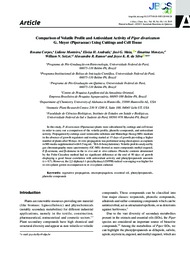Comparison of volatile profile and antioxidant activity of Piper divaricatum G. Meyer (Piperaceae) using cuttings and cell tissue.
Comparison of volatile profile and antioxidant activity of Piper divaricatum G. Meyer (Piperaceae) using cuttings and cell tissue.
Author(s): CORPES, R.; MONTEIRO, L.; ANDRADE, E. H.; MAIA, J. G.; MENEZES, I. C. de; SETZER, W. N.; RAMOS, A. R.; SILVA, J. K. R. da
Summary: In this study, P. divaricatum (Piperaceae) plants were subcultured by cuttings and cell tissue in order to carry out a comparison of the volatile profile, phenolic compounds, and antioxidant activity. Propagation by cuttings used vermiculite substrate and Murashige-Skoog (MS) medium in the absence of growth regulators and rooting started at 15 days of growth providing a higher number of plants after 90 days. In vitro propagation was performed using shoot apices as explants in MS media supplemented with 0.5 mg mL-1 BA (6-benzyladenine). Volatile profiles analyzed by gas chromatography-mass spectrometry (GC-MS) showed as main compounds methyl eugenol, E-?-ocimene, and ?-elemene in the in vivo and in vitro cultures. Phenolic contents determined by the Folin-Ciocalteu method had no significant difference at the end of 90 days of growth displaying a good linear correlation with antioxidant activity and phenylpropanoids amounts (r > 0.7). However, the 2,2-diphenyl-1-picrylhydrazyl (DPPH) radical scavenging was higher for in vitro plants grown in comparison to in vivo plants cultured.
Publication year: 2019
Types of publication: Journal article
Unit: Embrapa Eastern Amazon
Keywords: Antioxidante, Micropropagação, Piperaceae, Propagação Vegetativa
Observation
Some of Embrapa's publications are published as ePub files. To read them, use or download one of the following free software options to your computer or mobile device. Android: Google Play Books; IOS: iBooks; Windows and Linux: Calibre.
Access other publications
Access the Agricultural Research Database (BDPA) to consult Embrapa's full library collection and records.
Visit Embrapa Bookstore to purchase books and other publications sold by Embrapa.

